

Catholic Campaign for Human Development. How does US healthcare compare to the rest of the world? US healthcare reform bill: House speaker Nancy Pelosi and majority leader Steny Hoyer during a night news conference on health care reform Photograph: YURI GRIPAS/AFP/Getty Images Barack Obama has finally got his healthcare reform bill fought through Congress, bringing near-universal coverage to Americans and delivering the first major triumph of his presidency.
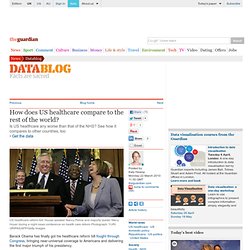
During the campaign, the NHS became the butt of increasingly outlandish political attacks in the US as Republicans and conservative campaigners railed against Britain's "socialist" system as part of a tussle to defeat the proposals. But how does the US compare? We've looked at some key indicators on healthcare, from countries in the G8 - plus Cuba and China, thanks to the World Health Organisation.
Take a look and let us know what you can do with them. Download the data • DATA: download the full data on healthcare as a spreadsheet World government data. Library: State of Homelessness in America 2011. Report | January 11, 2011 Files: Executive Summary (PDF | 316 KB | 6 pages) State of Homelessness in America 2011 (PDF | 5.05 MB | 48 pages) Since the release of Homelessness Counts: Changes in Homelessness from 2005 to 2007, the Alliance has chronicled changes in the levels of homelessness in the nation and in individual states and communities to chart our progress toward the goal of ending homelessness.
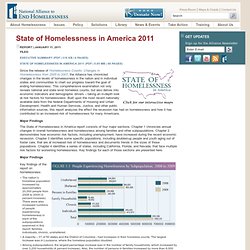
This comprehensive examination not only reveals national and state level homeless counts, but also delves into economic indicators and demographic drivers – taking an in-depth look at risk factors for homelessness. Built upon the most recent nationally available data from the federal Departments of Housing and Urban Development, Health and Human Services, Justice, and other public information sources, this report analyzes the effect the recession has had on homelessness and how it has contributed to an increased risk of homelessness for many Americans.
Major Findings Economic Indicators. Almost 1 in 5 Americans Going Without Health Care. MONDAY, Dec. 3 (HealthDay News) -- Almost 20 percent of Americans, or more than 40 million adults, can't afford or access needed health care, according to a new U.S. government report released Monday.
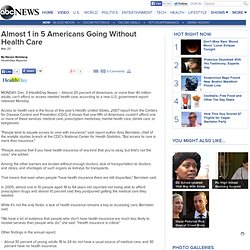
Access to health care is the focus of this year's Health, United States, 2007 report from the Centers for Disease Control and Prevention (CDC). It shows that one-fifth of Americans couldn't afford one or more of these services: medical care, prescription medicines, mental health care, dental care, or eyeglasses. "People tend to equate access to care with insurance," said report author Amy Bernstein, chief of the analytic studies branch at the CDC's National Center for Health Statistics.
"But access to care is more than insurance. " "People assume that if you have health insurance of any kind that you're okay, but that's not the case," she added. That means that even when people "have health insurance there are still disparities," Bernstein said. Three-Quarters of U.S. Jobless Can't Afford Health Care: Report. WEDNESDAY, Aug. 24 (HealthDay News) -- Nearly three-quarters of jobless Americans say they can't afford needed health care or prescription drugs, and about half say they're struggling with medical bills or medical debt, a new report reveals.
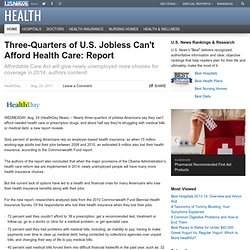
Sixty percent of working Americans rely on employer-based health insurance, so when 15 million working-age adults lost their jobs between 2008 and 2010, an estimated 9 million also lost their health insurance, according to the Commonwealth Fund report. Poverty Rate by Race/Ethnicity. Poverty and health care in America: the unavoidable facts. A talk by health care critic Dr.
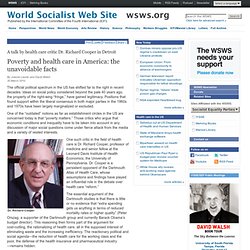
Richard Cooper in Detroit By Joanne Laurier and David Walsh 30 March 2010. Poverty rate rises as incomes decline - Census - Sep. 13. NEW YORK (CNNMoney) -- Amid a still struggling economy, more people in America fell below the poverty line last year, according to new census data released Tuesday. The nation's poverty rate rose to 15.1% in 2010, its highest level since 1993. In 2009, 14.3% of people in America were living in poverty. "The results are not surprising given the economy," said Paul Osterman, author of "Good Jobs America," and a labor economist at MIT. "You would expect with so many people unemployed, the poverty rate would go up. It's just another sign of what a difficult time this is for so many people.
" About 46.2 million people are now considered in poverty, 2.6 million more than last year. National Poverty Center. How does the United States measure poverty?

The United States determines the official poverty rate using poverty thresholds that are issued each year by the Census Bureau. The thresholds represent the annual amount of cash income minimally required to support families of various sizes. Understanding Poverty in the U.S. The U.S.
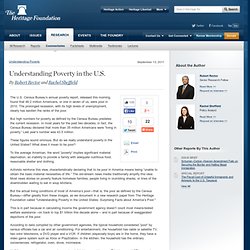
Economy Impacting the Number of Homeless in South Dakota. PIERRE, S.D. – December 4, 2009 – (RealEstateRama) — A recent homeless count and survey conducted by South Dakota Housing for the Homeless Consortium (SDHHC) indicates that the economy has impacted the number of homeless individuals and families in South Dakota.
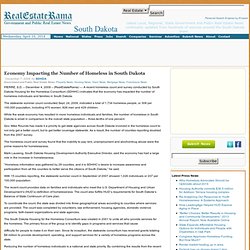
The statewide summer count conducted Sept. 24, 2009, indicated a total of 1,734 homeless people, or 308 per 100,000 population, including 470 women, 826 men and 429 children.